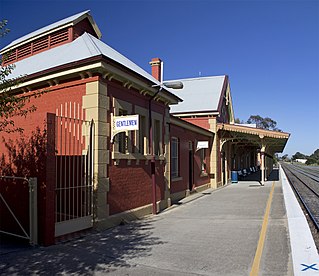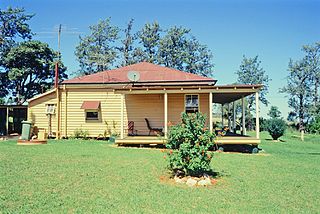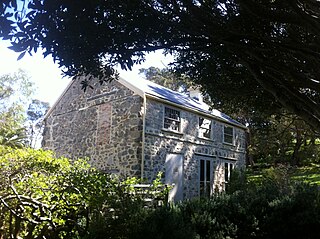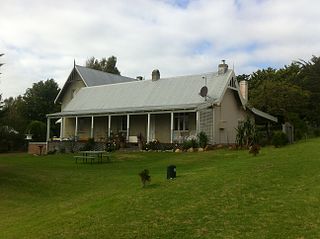
Albany is a port city in the Great Southern region in the Australian state of Western Australia, 418 km southeast of Perth, the state capital. Albany is the oldest colonial settlement in Western Australia, predating Perth and Fremantle by over two years.

Queanbeyan railway station is a heritage-listed railway station located on the Bombala line in New South Wales, Australia. It serves the town of Queanbeyan.

Australian residential architectural styles have evolved significantly over time, from the early days of structures made from relatively cheap and imported corrugated iron to more sophisticated styles borrowed from other countries, such as the Victorian style from the United Kingdom, the Georgian style from North America and Europe and the Californian bungalow from the United States. A common feature of the Australian home is the use of fencing in front gardens, also common in both the UK and the US.

Canning Downs was the first residential establishment built by a white person on the Darling Downs in Queensland, Australia. It is located a short drive from the town of Warwick and originally extended south east to Killarney and the McPherson Range. The area was first named after the British statesman George Canning by Allan Cunningham.

Butterly House, also known as Monger's Cottage, is located at 1A-D Harper Road, Toodyay, Western Australia. The building was the location of the first bank in Toodyay.

O'Shea's Drayton Cottage is a heritage-listed cottage at 56 Gwynne Street, Drayton, Toowoomba Region, Queensland, Australia. It was built from c. 1874 to 1910s circa. It was added to the Queensland Heritage Register on 27 April 2001.

Clifford House is a heritage-listed club house at 120 Russell Street, Toowoomba, Toowoomba Region, Queensland, Australia. It was built c. 1865. It was added to the Queensland Heritage Register on 21 October 1992.

McWhinneys Brick Cottage is a heritage-listed cottage at 47-55 Birley Street, Spring Hill, City of Brisbane, Queensland, Australia. It was built in the 1860s for Thomas McWhinney. It was added to the Queensland Heritage Register on 23 February 2001.

Fernleigh is a heritage-listed cottage at 73 Shore Street East, Cleveland, City of Redland, Queensland, Australia. It was built c. 1860s. It was added to the Queensland Heritage Register on 11 March 1994.

The Old Farm is located on Strawberry Hill in the suburb of Mira Mar in Albany, Western Australia. It is known as being the first farm in Western Australia.

Camfield House, also referred to as Annesfield, is a conglomerate of buildings in Albany in the Great Southern region of Western Australia.

The Residency Museum, also referred to as the Albany Residency or Western Australian Museum - Albany, is a museum in Albany in the Great Southern region of Western Australia.

The Royal George Hotel is a heritage listed building that operates as a hotel in Albany in the Great Southern region of Western Australia.

Brick Cottage is a heritage-listed cottage now used as a museum at 8 Simon Street, Gayndah, North Burnett Region, Queensland, Australia. It was built in 1864 by Henry Fenwick. It is now known as Gayndah Museum. It was added to the Queensland Heritage Register on 14 December 2001.

Weidmann Cottage is a heritage-listed former retail building, residence and town house and now unused building located at 132 Bridge Street, Muswellbrook in the Muswellbrook Shire local government area of New South Wales, Australia. It was built from 1840 to 1845. The property is owned by Muswellbrook Shire Council and was added to the New South Wales State Heritage Register on 2 April 1999.

Bridge View Inn is a heritage-listed former hotel and bank building which now contains bed and breakfast accommodation, a museum and commercial enterprises at 28-30 Louee Street, Rylstone, Mid-Western Regional Council, New South Wales, Australia. It was built from 1860 to 1870. It is also known as Bridge Hotel, Rylstone Historical Society Building and Bridgeview Inn. The property is owned by Rylstone and District Historical Society. It was added to the New South Wales State Heritage Register on 2 April 1999.

Jellore Cottage is a heritage-listed house at 16 Jellore Street, Berrima, Wingecarribee Shire, New South Wales, Australia. It is also known as Munday Cottage. It was added to the New South Wales State Heritage Register on 2 April 1999.

Mail Coach Inn is a heritage-listed former inn and residence at 24 Jellore Street, Berrima, Wingecarribee Shire, New South Wales, Australia. It was built from 1833 to 1841. It is also known as the Royal Mail Coach Inn. It traded in recent times as a now-closed bed and breakfast known as the Coach and Horses Inn; however, that name historically referred to a different Berrima hotel. It was added to the New South Wales State Heritage Register on 2 April 1999.

Cox's Cottage is a heritage-listed pasturing land and residence located at 2 St Thomas Road in the western Sydney suburb of Mulgoa in the City of Penrith local government area of New South Wales, Australia. It was built from 1810 to 1811 by James King. It is also known as Mulgoa Cottage; The Cottage, Coxs Cottage, and was formally known as Fern Hill and Estate of Mulgoa before the new house was built. The property remains privately owned and is the oldest house in Australia still in residence. It was added to the New South Wales State Heritage Register on 2 April 1999.

The 203-205 Albion Street, Surry Hills Cottages are two heritage-listed cottages located at 203-205 Albion Street in the inner city Sydney suburb of Surry Hills in the City of Sydney local government area of New South Wales, Australia. It was built in 1840 by George Hill. The property is owned by the Royal College of Pathologists of Australasia. It was added to the New South Wales State Heritage Register on 2 April 1999.






















